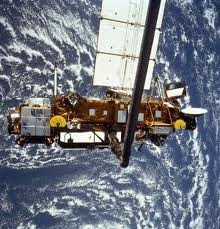
While North America appears to be off the hook, scientists are scrambling to pinpoint exactly where and when a dead NASA climate satellite will plummet back to Earth on Friday.
The 6-ton, bus-sized satellite is expected to break into more than a hundred pieces as it plunges through the atmosphere, most of it burning up.
But if you're hoping for a glimpse, the odds are slim. Most sightings occur by chance because the re-entry path can't be predicted early enough to alert people, said Canadian Ted Molczan, who tracks satellites for a hobby.
In all his years of monitoring, Molczan has witnessed only one tumble back to Earth - the 2004 return of a Russian communications satellite.
It "looked like a brilliant star with a long glowing tail," he said in an email.
The best guess so far is that the 20-year-old Upper Atmosphere Research Satellite will hit sometime Friday afternoon or early evening, Eastern time. The latest calculations indicate it will not be over the United States, Canada and Mexico during that time.
Read More
The 6-ton, bus-sized satellite is expected to break into more than a hundred pieces as it plunges through the atmosphere, most of it burning up.
But if you're hoping for a glimpse, the odds are slim. Most sightings occur by chance because the re-entry path can't be predicted early enough to alert people, said Canadian Ted Molczan, who tracks satellites for a hobby.
In all his years of monitoring, Molczan has witnessed only one tumble back to Earth - the 2004 return of a Russian communications satellite.
It "looked like a brilliant star with a long glowing tail," he said in an email.
The best guess so far is that the 20-year-old Upper Atmosphere Research Satellite will hit sometime Friday afternoon or early evening, Eastern time. The latest calculations indicate it will not be over the United States, Canada and Mexico during that time.
Read More